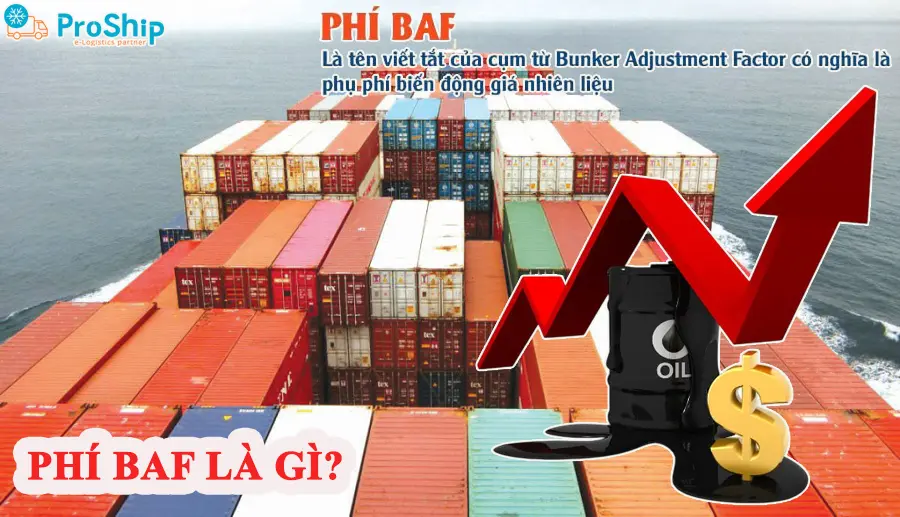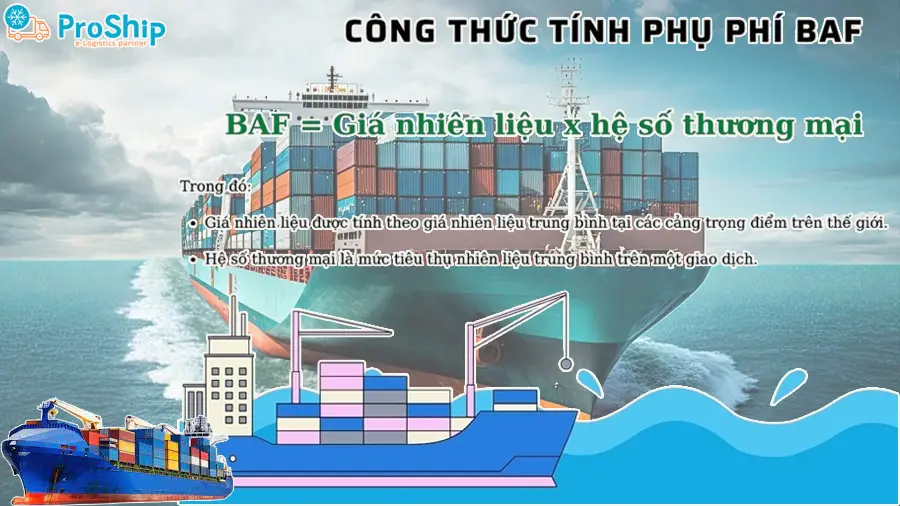x Bạn đang tham gia vào hoạt động xuất nhập khẩu hàng hóa qua đường biển nên cần tìm hiểu về BAF là phí gì, viết tắt của từ gì?
x Bạn muốn biết phụ phí BAF có vai trò gì, thu để làm gì, bên nào chịu trách nhiệm chi trả khoản phí này trong vận tải biển?
x Bạn thắc mắc phí BAF trong XNK được tính theo công thức nào?
BAF là phí gì, quy định ra sao, đóng vai trò quan trọng thế nào,…sẽ được Proship.vn chúng tôi chia sẻ nhanh trong khuôn khổ bài viết này. Đồng thời qua đây, các bên liên quan cũng sẽ biết được ngoài phí BAF sẽ còn một số phụ phí khác nữa trong quá trình xuất, nhập khẩu hàng hóa nói chung.
BAF là phí gì? Ai quy định, bên nào đóng phí? Nguồn gốc ra đời?
Cùng Proship tìm hiểu xem phụ phí BAF là gì, viết tắt của từ gì, nguồn gốc ra đời, ai quy định và bên nào phải đóng phí ngay sau đây:
Phí BAF là phí gì?
BAF là phí gì? Phí BAF (hay Bunker Adjustment Factor), là khoản phí bổ sung trên cước biển, được áp đặt để điều chỉnh chi phí do biến động giá nhiên liệu. Đây là biện pháp nhằm bù đắp những thay đổi liên quan đến giá nhiên liệu và đảm bảo tính cân đối trong giá cước biển. Thuật ngữ tương đương là FAF (Fuel Adjustment Factor).
Phí BAF thể hiện sự nhạy cảm đối với sự biến đổi liên tục của giá nhiên liệu trên thị trường toàn cầu. Các biến động này có thể phụ thuộc vào tình hình cung cấp và cầu đối với nhiên liệu, sự biến đổi trong sản xuất dầu, biến động giá dầu thô và các yếu tố khác.

Phụ phí BAF do ai quy định? Bên nào cần đóng?
Phụ phí BAF được quy định bởi các hãng tàu và dựa trên công thức tính toán của họ. Người phải đóng phụ phí BAF thường là bên thanh toán cước vận chuyển hàng hóa qua đường biển.
Thông thường, bên thanh toán cước vận chuyển có thể là bên xuất khẩu (EXW) hoặc bên nhập khẩu (CIF, DDP). Trong một số trường hợp, bên xuất khẩu và nhập khẩu có thể thỏa thuận chia sẻ phụ phí BAF theo tỷ lệ nhất định.
Nguồn gốc ra đời của phí BAF trong xuất nhập khẩu
BAF là phí gì đã được giải đáp. Vậy, nguồn gốc xuất hiện phụ phí này từ đâu?Vào những năm 1970, thế giới đã chứng kiến cuộc khủng hoảng giá dầu lửa khi giá nhiên liệu tăng đột biến với biên độ cực lớn. Trong tình hình đó, nhiều hãng tàu và đơn vị vận chuyển gặp khó khăn lớn khi giá nhiên liệu thay đổi không đáng kể, ảnh hưởng đến lợi nhuận của họ.
Để đảm bảo hàng hóa đến đích đúng thời hạn, các đơn vị chủ hàng yêu cầu tàu vận tải container duy trì tốc độ cao, khiến chi phí nhiên liệu trở nên cực kỳ đáng kể. Trong khi đó, giá xăng dầu liên tục tăng, các hãng tàu không đủ thời gian để điều chỉnh giá cước dẫn đến thiệt hại về lợi nhuận khá đáng kể. Trong hoàn cảnh này, chi phí nhiên liệu được sử dụng trở thành yếu tố không thể thiếu trong hoạt động giao thương, mua bán hàng hóa.
Cách tính phí BAF trong xuất nhập khẩu
Cách tính phí BAF thường khá phức tạp. Dưới đây là một số yếu tố cơ bản được xem xét khi tính phí:
Mức tiêu thụ nhiên liệu
Số liệu về mức tiêu thụ nhiên liệu của tàu vận chuyển được sử dụng để tính toán phí BAF. Mức tiêu thụ nhiên liệu thay đổi tùy vào tốc độ và kích thước của tàu;
Giá nhiên liệu hiện tại
Phí BAF thường dựa trên giá nhiên liệu hiện tại, được theo dõi và cập nhật theo thời gian thực;
Các yếu tố ảnh hưởng khác
Ngoài giá nhiên liệu và mức tiêu thụ, các yếu tố như quy định hải quan, thay đổi trong kích thước tàu và tình hình cung cấp và yêu cầu cũng có thể được xem xét khi tính toán phí BAF.

Thông thường sẽ được tính toán theo công thức sau:
BAF = Giá nhiên liệu x Hệ số thương mại
* Trong đó:
- Giá nhiên liệu: Giá nhiên liệu trung bình tại các cảng trọng điểm thế giới.
- Hệ số thương mại: Mức tiêu thụ nhiên liệu trung bình trên một giao dịch.
Vai trò của phí BAF trong xuất nhập khẩu là gì?
Trong quá trình tìm hiểu BAF là phí gì, Nhà kinh doanh cũng nên hiểu rõ vai trò của khoản phí này trong xuất nhập khẩu. Đối với các hãng tàu vận chuyển và các bên liên quan, BAF đóng vai trò quan trọng như:
Duy trì sự ổn định về chi phí
Cơ cấu chi phí của hãng tàu, đơn vị vận chuyển được giữ ổn định ở một mức nào đó. Điều này giúp doanh nghiệp dự đoán và quản lý các chi phí vận chuyển hiệu quả hơn.
Duy trì lợi nhuận
Bù đắp những biến động xảy đến với giá nhiên liệu trên thị trường quốc tế. Điều này giúp hãng tàu tránh được những tổn thất về lợi nhuận do giá bán nhiên liệu đốt tăng cao.
Đảm bảo tiến độ vận chuyển đơn hàng được đúng kế hoạch
Với người mua, phí BAF đảm bảo đơn vị vận tải duy trì được tốc độ đi hàng và chất lượng dịch vụ. Từ đó, hàng sẽ về cảng nhận đúng thời gian.
Chia sẻ chi phí vận tải
Phụ phí này được tính trên công thức hay một tỷ lệ nhất định và hãng tàu sẽ thu khoản phí này từ bên xuất hoặc nhập khẩu. Sự phân chia tạo ra yếu tố công bằng giữa các bên khi tham gia vào hoạt động xuất nhập khẩu và vận chuyển.
Hạn chế rủi ro
BAF là giải pháp bù đắp hiệu quả, giúp các Đơn vị vận tải có thể giảm thiểu tối đa tác động tiêu cực từ sự biến động giá nhiên liệu đối với lợi nhuận.
Các loại phí khác ngoài phí BAF, bạn cần biết
Ngoài phí BAF (phí điều chỉnh nhiên liệu), các chủ hàng cũng phải đối mặt với nhiều loại phí khác, bao gồm:
Phụ phí DDC (Destination Delivery Charge)
Hay còn gọi là phụ phí giao hàng ở cảng đích. Khoản thu này được sử dụng để phục vụ cho hoạt động dỡ hàng và sắp xếp container ở trong cảng. Số tiền thu được sẽ sử dụng để chi trả cho phí ra vào cổng/cảng.
Phí CIC (Container Imbalance Charge)
Là phụ phí về mất cân đối container. Mục tiêu của phí là để bù đắp chi phí vận chuyển container trống từ nơi thừa đến nơi thiếu.
Phí CAF (Currency Adjustment Factor)
Là phí điều chỉnh theo biến động tỷ giá ngoại tệ. Tương tự như BAF, các hãng tàu quy định và thu phí này từ các chủ hàng để bù đắp cho biến động của tỷ giá ngoại tệ trong quá trình vận chuyển hàng hóa.

Phí GRI (General Rate Increase)
Là phụ phí cước vận chuyển tăng vào mùa cao điểm, đặc biệt trong các mùa lễ Giáng sinh ở thị trường châu Âu.
Phí LSS (Low Sulphur Surcharge)
Là mức phí về giảm thiểu thải lưu huỳnh. Khoản này được thu khi hoạt động xả thải khí lưu huỳnh vượt quá mức quy định.
Phí PSS (Peak Season Surcharge)
Là phí áp dụng vào mùa cao điểm. Thường, các hãng tàu sẽ thu phí này cho những chuyến vận chuyển vào mùa cao điểm, từ khoảng tháng 8 đến tháng 10 hàng năm hoặc từ tháng 11 đến tháng 1 của năm tiếp theo.
BAF là phí gì cùng những kiến thức liên quan tới phụ phí biến động giá nhiên liệu Bunker Adjustment Factor như nguồn gốc, vai trò, quy định, cách tính phí,…đã được Proship chia sẻ. Theo đó, nếu các doanh nghiệp, chủ hàng, nhà vận chuyển, bên bán, bên mua,…đang băn khoăn về khoản phụ phí này thì nên cập nhật thông tin trên hoặc liên hệ ngay 0909 344 247 để được giải đáp mọi thắc mắc về phí, phụ phí trong XNK đường biển.

